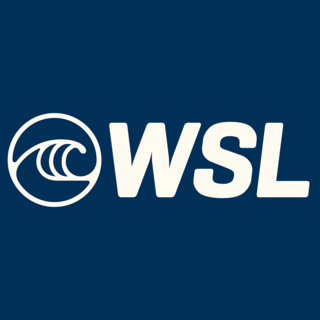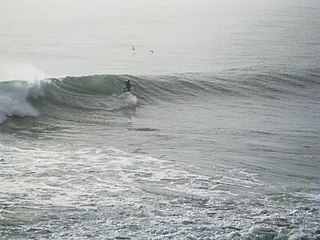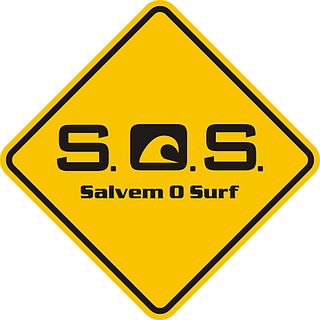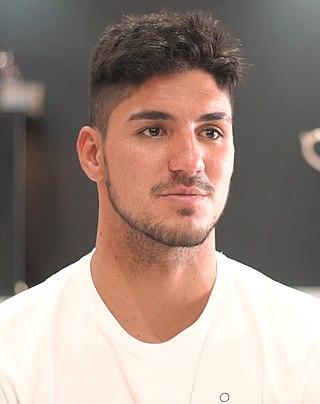
Surfing is a surface water sport in which an individual, a surfer, uses a board to ride on the forward section, or face, of a moving wave of water, which usually carries the surfer towards the shore. Waves suitable for surfing are primarily found on ocean shores, but can also be found in standing waves in the open ocean, in lakes, in rivers in the form of a tidal bore, or in wave pools.

Robert Kelly Slater is an American professional surfer, best known for being crowned World Surf League champion a record 11 times. Slater is widely regarded as the greatest professional surfer of all time, and holds 56 Championship Tour victories. Slater is also the oldest surfer still active on the World Surf League, winning his 8th Billabong Pipeline Masters title at age 49.

Big wave surfing is a discipline within surfing in which experienced surfers paddle into, or are towed into, waves which are at least 20 feet high, on surf boards known as "guns" or towboards. Sizes of the board needed to successfully surf these waves vary by the size of the wave as well as the technique the surfer uses to reach the wave. A larger, longer board allows a rider to paddle fast enough to catch the wave and has the advantage of being more stable, but it also limits maneuverability and surfing speed.

Tow-in surfing is a surfing technique which uses artificial assistance to allow the surfer to catch faster moving waves than was traditionally possible when paddling by hand. Tow-in surfing was invented by surfers who wanted to catch big waves and break the 30 ft (9 m) barrier. It has been one of the biggest breakthroughs in surfing history.

Nazaré is a Portuguese town and municipality located in the Oeste region, in the historical province of Estremadura, and in the Leiria District. The municipality has a population of 14,889 in an area of 82.43 km2, while the town itself has around 10,000 inhabitants.

Jardim do Mar is a civil parish in the western part of the municipality of Calheta in the Portuguese island of Madeira. The population in 2011 was 204, in an area of 0.74 km². It is approximately 3 kilometres (1.86 mi) northwest of Calheta.

Paul do Mar is a civil parish in the municipality of Calheta, in the Portuguese archipelago of Madeira. The population in 2011 was 871, in an area of 1.40 km2.

Surf culture includes the people, language, fashion, and lifestyle surrounding the sport of surfing. The history of surfing began with the ancient Polynesians. That initial culture directly influenced modern surfing, which began to flourish and evolve in the early 20th century, with its popularity peaking during the 1950s and 1960s. It has affected music, fashion, literature, film, art, and youth jargon in popular culture. The number of surfers throughout the world continues to increase as the culture spreads.

The World Surf League (WSL) is the governing body for professional surfers and is dedicated to showcasing the world's best talent in a variety of progressive formats. The World Surf League was originally known as the International Professional Surfing founded by Fred Hemmings and Randy Rarick in 1976. IPS created the first world circuit of pro surfing events. In 1983 the Association of Surfing Pros took over management of the world circuit. In 2013, the ASP was acquired by ZoSea, backed by Paul Speaker, Terry Hardy, and Dirk Ziff. At the start of the 2015 season, the ASP changed its name to the World Surf League. Sophie Goldschmidt was appointed as WSL CEO on 19 July 2017. Paul Speaker had stepped down as CEO on 11 January 2017, and Dirk Ziff acted as the interim WSL CEO until Goldschmidt's appointment.

Torres is a city on the coast of south Brazil in the state of Rio Grande do Sul. The city has a population of approximately 40,000 inhabitants, of which 10,000 live in rural zones, but in summer the number of inhabitants reaches 300,000.

A surf break is a permanent obstruction such as a coral reef, rock, shoal, or headland that causes a wave to break, forming a barreling wave or other wave that can be surfed, before it eventually collapses. The topography of the seabed determines the shape of the wave and type of break. Since shoals can change size and location, affecting the break, it takes commitment and skill to find good breaks. Some surf breaks are quite dangerous, since the surfer can collide with a reef or rocks below the water.

Chile has many beaches for surfing, especially in the northern region where the weather conditions attract many surfers from all over the world. Except for the winter months surfing is possible all year. The water temperature ranges from 15 to 20 °C. Although the waves in central Chile are bigger, the waves in the north are stronger and are usually better suited for surfing. The cold waters of central and southern Chile can be brutal to surf, therefore, surfers adventuring into those areas are strongly advised on using a protective wetsuit to protect against the elements.

Maya Reis Gabeira is a Brazilian big wave surfer. She is best known for having surfed a 22.4 m (73 ft) high wave in Nazaré, Portugal in February 2020, recorded by Guinness World Records as the biggest wave ever surfed by a woman. She also held the previous record for biggest wave ever surfed by a woman, of 20.8 m (68 ft) established in January 2018.

S.O.S. Salvem O Surf is an environmental non-governmental organisation in Portugal, with a strong technical profile, that aims to solve problems and issues related with Surfing but also to develop the sport. It strives to solve problems constructively, guided by the need to raise awareness of the value of surf, and the will to create added value to all the involved parties.

Garrett "GMAC" McNamara is an American professional big wave surfer best known for setting the world record for largest wave ever surfed, as documented in the HBO series 100 Foot Wave. McNamara is also known for successfully negotiating a monstrous barrel at Jaws, and being the first person ever to ride a wave formed from calving glaciers.
The Association of Surfing Professionals Europe is the governing body for professional surfers in Europe and is dedicated to showcasing the continent's best talent in a variety of progressive formats. It is one of seven regions of the ASP World Tour.

Gabriel Medina Pinto Ferreira is a Brazilian professional surfer who won the 2014, 2018 and 2021 WSL World Championships. With 17 WSL Championship Tour (CT) event wins and 29 Final appearances under his belt, Medina is one of the most experienced surfers when it comes to producing the best surfing under pressure. Medina is 2nd only to Kelly Slater for the most World Titles among surfers currently on the CT.

Women's surfing is thought to date back to the 17th century. One of the earliest records of women surfing is of princess Keleanohoana’api’api, also known as Kalea or the Maui Surf Riding Princess. It is rumored that Kalea was the trailblazer of surfing and could surf better than both men and women. A few centuries later in the mid-late 1800s, Thrum’s Hawaiian Annual reported that women in ancient Hawaii surfed in equal numbers and frequently better than men. Over the last 50 years, women's surfing has grown in popularity.
MEO Rip Curl Pro Portugal formerly known as MEO Pro Portugal, Moche Rip Curl Pro Portugal or Rip Curl Pro Portugal is a professional surfing competition of the WSL World Tour. As of 2022, held every year in March at the Supertubos beach in Peniche, Portugal. The event was first founded in 2010 as Rip Curl Pro Portugal.

Praia do Norte is a beach located in Nazaré, Portugal, which due to its giant white breaking waves is famed for its surfing conditions. Nazaré's waves were listed on the Guinness Book of Records for the biggest waves ever surfed.


















